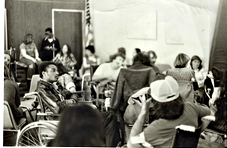

Bradley Lomax with other demonstrators inside the San Francisco Federal Building in April 1977. Credit: Glenn Lomax
This year the award-winning movie “Crip Camp: A Disability Revolution” was released and can now be viewed on Netflix’s streaming service. The movie follows Jimmy LeBrecht, a camper, who co-wrote and co-directed the movie, and Judy Heumann, a camp counselor who went on to co-found Disabled in Action.


Bradley Lomax with other demonstrators inside the San Francisco Federal Building in April 1977. Credit: Glenn Lomax
Crip Camp was the campers’ name for Camp Jened, which opened in the 1950s. In 1970, LeBrecht went to camp, where, for a brief period, he lived in an environment geared entirely to people with disabilities. Because everyone needed some kind of assistance, no one’s personal needs stood out as “different.”
LeBrecht said, “When we were there, there was no outside world.” The movie underscores the impact of what it means to be part of a community.
After camp and college, Heumann and LeBrecht ended up in Berkeley, Calif., where they connected with the activism surrounding the Center for Independent Living. For people with disabilities, independent living means having autonomy, self-respect and the accessibility, support and programs necessary to provide equal opportunities in all aspects of life.
The movie shifts to focus on the nearly monthlong sit-in at the federal offices of the Department of Health, Education and Welfare (now Health and Human Services) in San Francisco to demand enforcement of Section 504 of the Rehabilitation Act of 1973. The legislation prohibited discrimination against people with disabilities. This meant making buildings, workplaces, cities and public transportation accessible.
After four years of government inaction, demonstrations were held across the country on April 5, 1977, to demand full enforcement of Section 504. Several sit-ins were held at federal HEW offices. Three hundred disabled people occupied the department’s headquarters for over a day in Washington, D.C. People sat in for at least four days in Atlanta, Boston, Chicago, Denver, Los Angeles, Philadelphia and Seattle.
History made in San Francisco
Five hundred people rallied outside the San Francisco Federal Building, and Heumann led 150 activists into the HEW offices. The spontaneous 28-day occupation was able to survive by support from disabled people and organizations, particularly the Oakland Black Panther Party — which provided hot meals every day. The Black Panther newspaper became the source of information about the sit-in.
Bradley Lomax, who coordinated a Black Panther Party program with the Center for Independent Living, participated in the sit-in, along with his care assistant Chuck Jackson.
Kitty Cone, a lesbian organizer in the Center for Independent Living Community Affairs Department, brought in allies. Susan Schweik explains in “Lomax’s Matrix: Disability, Solidarity and the Black Power of 504,” that Cone “included the Butterfly Brigade, ‘a group of gay men who patrolled city streets on the lookout for gay violence,’ who smuggled walkie-talkies into the occupied building; Glide Church; local and national labor organizations; members of Delancey Street, the famous grassroots rehab program for substance abusers and former felons, who brought breakfast into the building each day; the Chicano group Mission Rebels, who also provided food… .” (Disability Studies Quarterly, Vol. 31, No. 1 (2011))
504 sit-ins proved activism brings changes
A contingent of the 504 protesters was sent from San Francisco to Washington to confront HEW Secretary Joseph Califano, calling on him to enforce the regulations. Included in the group were Lomax, Jackson and Heumann. Soon afterwards, Califano conceded and agreed to the demands.
When Heumann moved to New York City, she helped to found Disabled In Action and played a large role in pushing through the Americans with Disabilities Act, which was finally signed in 1990.
That too required mass action and dramatic efforts. In a demonstration organized by Disabled in Action on March 12, 1990, dozens of disabled people crawled up the stone steps of the inaccessible Capitol Building in Washington, D.C., to emphasize the lack of access that still existed nearly 20 years after the 504 sit-ins.
Even now, nearly 50 years later, the most minimal of implementation has been done. Living with disabilities remains a constant struggle.
“Crip Camp” takes you inside the lives of several other campers and counselors as well. It is a movie that gives strength and brings joy, even with its limitation of reinforcing the false image of the disability rights movement being a white-led struggle.
Bowdish is a member of the Disability Rights Caucus of Workers World Party.
The epic struggle of the Palestinian people against the full weight of U.S. imperialism and…
The following report comes from the Bronx Anti-War Coalition organizers on a protest held in…
In the Canadian federal elections held on April 28, the Liberals won with 169 seats…
The following is Part 2 of a talk given by the author to a meeting…
Boston Students, professors and workers are confronting the Trump administration’s fascist crackdown at universities across…
Philadelphia Within days of Swarthmore students reviving a pro-Palestinian encampment on April 30, police arrested…